Preceded by Carlos Prio Socarras Name Fulgencio Batista Succeeded by Ramon Grau | Preceded by Federico Laredo Bru | |
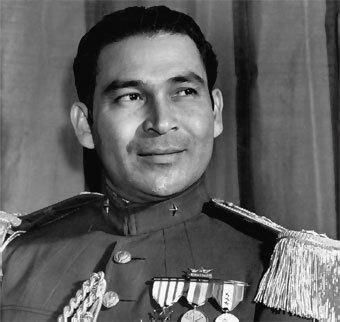 | ||
Prime Minister Andres DomingoJorge Garcia MontesAndres Rivero AgueroEmilio Nunez PortuondoGonzalo Guell Prime Minister Carlos Saladrigas ZayasRamon ZaydinAnselmo Alliegro Died August 6, 1973, Guadalmina Children Mirta Caridad Batista y Godinez Books Cuba betrayed, The growth and decline of the Cuban Republic Political party Liberal Party of Cuba, United Action Party, Progressive Action Party, Democratic Socialist Coalition Similar People | ||
Difilm cuba derrocamiento de fulgencio batista 1959
Fulgencio Batista y Zaldívar ([fulˈxensjo βaˈtista i salˈdiβar]; January 16, 1901 – August 6, 1973) was the elected President of Cuba from 1940 to 1944, and U.S.-backed dictator from 1952 to 1959, before being overthrown during the Cuban Revolution. Fulgencio Batista initially rose to power as part of the 1933 Revolt of the Sergeants that overthrew the provisional government of Carlos Manuel de Céspedes y Quesada. He then appointed himself chief of the armed forces, with the rank of colonel, and effectively controlled the five-member Presidency. He maintained this control through a string of puppet presidents until 1940, when he was himself elected President of Cuba on a populist platform. He then instated the 1940 Constitution of Cuba, considered progressive for its time, and served until 1944. After finishing his term he lived in Florida, returning to Cuba to run for president in 1952. Facing certain electoral defeat, he led a military coup that preempted the election.
Contents
- Difilm cuba derrocamiento de fulgencio batista 1959
- Fulgencio batista the last dictator of cuba
- Early life
- 1933 coup
- First presidency 19401944
- Post presidency
- Military coup and second presidency 19521959
- Economy of Cuba
- Relationship with organized crime
- Support of US business and government
- Batista Fidel Castro and the Cuban Revolution
- Personal life
- Death
- In popular culture
- Books written by Batista
- References
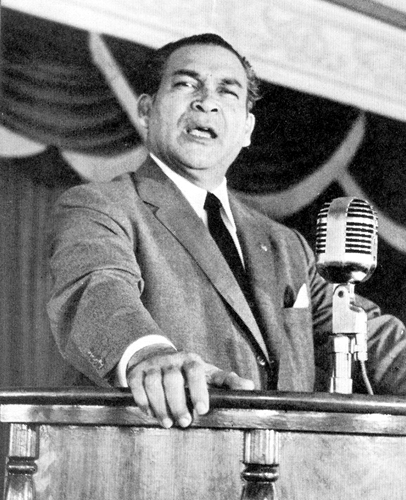
Back in power, and receiving financial, military, and logistical support from the United States government, Batista suspended the 1940 Constitution and revoked most political liberties, including the right to strike. He then aligned with the wealthiest landowners who owned the largest sugar plantations, and presided over a stagnating economy that widened the gap between rich and poor Cubans. Eventually it reached the point where most of the sugar industry was in U.S. hands, and foreigners owned 70% of the arable land. As such, Batista's increasingly corrupt and repressive government then began to systematically profit from the exploitation of Cuba's commercial interests, by negotiating lucrative relationships with both the American Mafia, who controlled the drug, gambling, and prostitution businesses in Havana, and with large U.S.-based multinational companies who were awarded lucrative contracts. To quell the growing discontent amongst the populace—which was subsequently displayed through frequent student riots and demonstrations—Batista established tighter censorship of the media, while also utilizing his Bureau for the Repression of Communist Activities secret police to carry out wide-scale violence, torture and public executions; ultimately killing anywhere from hundreds to 20,000 people.
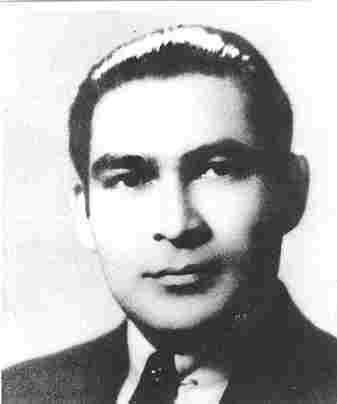
Catalyzing the resistance to such tactics, for two years (December 1956 – December 1958) Fidel Castro's 26th of July Movement and other nationalist rebelling elements led an urban and rural-based guerrilla uprising against Batista's government, which culminated in his eventual defeat by rebels under the command of Che Guevara at the Battle of Santa Clara on New Year's Day 1959. Batista immediately fled the island with an amassed personal fortune to the Dominican Republic, where strongman and previous military ally Rafael Trujillo held power. Batista eventually found political asylum in Oliveira Salazar's Portugal, where he first lived on the island of Madeira and then in Estoril, outside Lisbon. He was involved in business activities in Spain and was staying there in Guadalmina near Marbella at the time of his death from a heart attack on August 6, 1973.
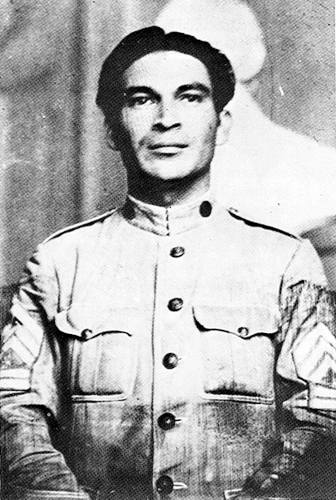
Fulgencio batista the last dictator of cuba
Early life
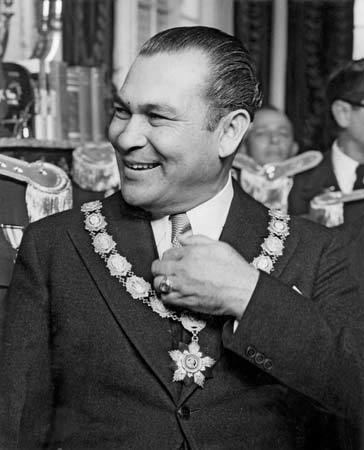
Batista was born in the town of Veguita, located in the municipality of Banes, Cuba, province of Holguín, in 1901, to Belisario Batista Palermo and Carmela Zaldívar González, who had fought in the Cuban War of Independence. He was of Spanish, African and Chinese descent. His mother named him Rubén and gave him her last name, Zaldívar. His father did not want to register him as a Batista. In the registration records of the Banes courthouse, he was legally Rubén Zaldívar until 1939, when, as Fulgencio Batista, he became a presidential candidate and it was discovered that this name did not exist.

Both Batista's parents are believed to have been of mixed race, and one may have had indigenous Caribbean blood. Batista was initially educated at a public school in Banes, and later attended night classes at an American Quaker school. He left home at age 14, after the death of his mother. Coming from a humble background, he earned a living as a laborer in the cane fields, docks, and railroads. He was a tailor, mechanic, charcoal vendor and fruit peddler. In 1921, he traveled to Havana and joined the army as a private in April that year. After learning shorthand and typing, Batista left the army in 1923, working briefly as a teacher of stenography before enlisting in the Guardia Rural (rural police). He transferred back to the army as a corporal, becoming secretary to a regimental colonel. In September 1933, he held the rank of sergeant stenographer and as such acted as the secretary of a group of non-commissioned officers who led a "sergeant's conspiracy" for better conditions and improved prospects of promotion.
1933 coup
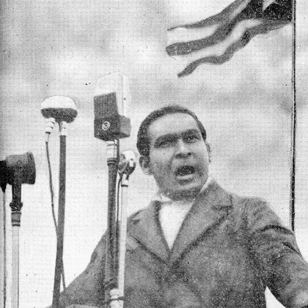
In 1933, Batista led an uprising called the Sergeants' Revolt, as part of the coup that overthrew the government of Gerardo Machado. Machado was succeeded by Carlos Manuel de Céspedes y Quesada, who lacked a political coalition that could sustain him and was soon replaced.
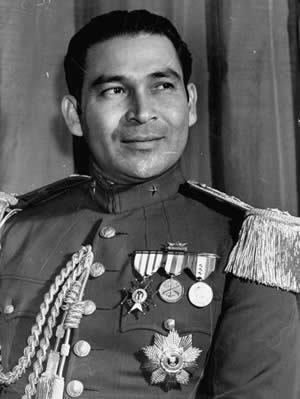
A short-lived five-member presidency, known as the Pentarchy of 1933, was established. It included a representative from each anti-Machado faction. Batista was not a member, but controlled Cuba's armed forces. Within days, the representative for the students and professors of the University of Havana, Ramón Grau San Martín, was made president—and Batista became the Army Chief of Staff, with the rank of colonel, effectively putting him in control of the presidency. The majority of the commissioned officer corps were forced to retire or, some speculate, were killed.
Grau remained president for just over 100 days before Batista, conspiring with the U.S. envoy Sumner Welles, forced him to resign in January 1934. Grau was replaced by Carlos Mendieta, and within five days the U.S. recognized Cuba's new government, which lasted eleven months. Batista then became the strongman behind a succession of puppet presidents until he was himself elected president in 1940. After Mendieta, succeeding governments were led by José Barnet (5 months) and Miguel Mariano Gómez (7 months) before Federico Laredo Brú ruled from December 1936 to October 1940.
First presidency (1940–1944)
Batista, supported by the Democratic Socialist Coalition which included Julio Antonio Mella's Communist Party, defeated Grau in the first presidential election under the new Cuban constitution in the 1940 election, and served a four-year term as President of Cuba, the first non-white Cuban in that office. Although Batista supported capitalism and admired the United States, he was endorsed by the old Communist Party of Cuba, which at the time had little significance and no chance of an electoral victory. This support was primarily due to Batista's labor laws and his support for labor unions, with which the Communists had close ties. In fact, Communists attacked the anti-Batista opposition, saying Grau and others were "fascists" and "reactionaries." During this term in office, Batista carried out major social reforms and established numerous economic regulations and pro-union policies.
Cuba entered World War II on the side of the Allies on December 8, 1941, declaring war on Japan the day after the attack on Pearl Harbor. On December 11, the Batista government declared war on Germany and Italy. In December 1942, after a friendly visit to Washington, Batista said Latin America would applaud a decision by the United Nations to go to war with Francisco Franco's Spain, calling the regime "fascist".
Post-presidency
In 1944, Batista's handpicked successor, Carlos Saladrigas Zayas, was defeated by Grau. In the final months of his presidency, Batista sought to handicap the incoming Grau administration. In a July 17, 1944, dispatch to the U.S. Secretary of State, U.S. Ambassador Spruille Braden wrote:
It is becoming increasingly apparent that President Batista intends to discomfit the incoming Administration in every way possible, particularly financially. A systematic raid on the Treasury is in full swing with the result that Dr. Grau will probably find empty coffers when he takes office on October 10. It is blatant that President Batista desires that Dr. Grau San Martin should assume obligations which in fairness and equity should be a matter of settlement by the present Administration.
Shortly after his successor was inaugurated, Batista left Cuba for the United States. "I just felt safer there," he said. He divorced his wife, Elisa, and married Marta Fernández Batista in 1945. Two of their four children were born in the United States.
For the next eight years, Batista remained in the background, spending time in the Waldorf-Astoria in New York City and a home in Daytona Beach, Florida.
He continued to participate in Cuban politics, and was elected to the Cuban Senate in absentia in 1948. Returning to Cuba, he decided to run for president and received permission from President Grau, whereupon he formed the United Action Party. On taking power he founded the Progressive Action Party, but he never regained his former popular support, though the unions supported him until the end.
Military coup and second presidency (1952–1959)
In 1952, Batista again ran for president. In a three-way race, Roberto Agramonte of the Orthodox Party led in all the polls, followed by Carlos Hevia of the Authentic Party. Batista's United Action coalition was running a distant third.
On March 10, 1952, three months before the elections, Batista, with army backing, staged a coup and seized power. He ousted outgoing President Carlos Prío Socarrás, canceled the elections and took control of the government as a provisional president. The United States recognized his government on March 27. When asked by the U.S. government to analyze Batista's Cuba, Arthur M. Schlesinger, Jr. said "The corruption of the Government, the brutality of the police, the government's indifference to the needs of the people for education, medical care, housing, for social justice and economic justice ... is an open invitation to revolution."
Again in power, Batista did not continue the progressive social policies of his earlier term. He wanted recognition by the upper strata of Cuban society, which had never accepted him in their social circles. He also worked to increase his personal fortune.
Economy of Cuba
Upon his seizure of power, Batista inherited a country that was relatively prosperous for Latin America. Although a third of the population still lived in poverty, Cuba was one of the five most developed countries in the region (According to the figures of the government of Batista). In the 1950s, Cuba's gross domestic product (GDP) per capita was roughly equal to that of Italy at the time, although Cuba's per-capita GDP was still only a sixth of that of the United States. Moreover, although corruption and inequality were rife under Batista, Cuban industrial workers' wages rose significantly. According to the International Labour Organization, the average industrial salary in Cuba was the world's eighth-highest in 1958, and the average agricultural wage was higher than some European nations. However, despite an array of positive indicators, in 1953, the average Cuban family only had an income of $6.00 a week, 15% to 20% of the labor force was chronically unemployed, and only a third of the homes had running water.
Relationship with organized crime
Brothels flourished. A major industry grew up around them; government officials received bribes, policemen collected protection money. Prostitutes could be seen standing in doorways, strolling the streets, or leaning from windows. One report estimated that 11,500 of them worked their trade in Havana. Beyond the outskirts of the capital, beyond the slot machines, was one of the poorest, and most beautiful countries in the Western world.
Throughout the 1950s, Havana served as "a hedonistic playground for the world's elite", producing sizable gambling, prostitution and drug profits for the American mafia, corrupt law-enforcement officials, and their politically elected cronies. In the assessment of the Cuban-American historian Louis Perez, "Havana was then what Las Vegas has become." Relatedly, it is estimated that by the end of the 1950s the city of Havana had 270 brothels. In addition, drugs, be it marijuana or cocaine, were so plentiful at the time that one American magazine in 1950 proclaimed "Narcotics are hardly more difficult to obtain in Cuba than a shot of rum. And only slightly more expensive." As a result, the playwright Arthur Miller described Batista’s Cuba in The Nation as "hopelessly corrupt, a Mafia playground, (and) a bordello for Americans and other foreigners." A 1956 issue of the tourism magazine Cabaret Quarterly, described Havana as "a mistress of pleasure, the lush and opulent goddess of delights."
In a bid to profit from such an environment, Batista established lasting relationships with organized crime, notably with American mobsters Meyer Lansky and Lucky Luciano, and under his rule Havana became known as "the Latin Las Vegas". Batista and Lansky formed a friendship and business relationship that flourished for a decade. During a stay at the Waldorf-Astoria in New York in the late 1940s, it was mutually agreed that, in return for kickbacks, Batista would give Lansky and the Mafia control of Havana's racetracks and casinos. After World War II, Luciano was paroled from prison on the condition that he permanently return to Sicily. Luciano secretly moved to Cuba, where he worked to resume control over American Mafia operations. Luciano also ran a number of casinos in Cuba with the sanction of Batista, though the American government eventually succeeded in pressuring the Batista government to deport him.
Batista encouraged large-scale gambling in Havana. In 1955, he announced that Cuba would grant a gaming license to anyone who invested US$1 million in a hotel or $200,000 in a new nightclub—and that the government would provide matching public funds for construction, a 10-year tax exemption, and waive duties on imported equipment and furnishings for new hotels. Each casino would pay the government $250,000 for the license, plus a percentage of the profits. The policy omitted background checks, as required for casino operations in the United States, which opened the door for casino investors with illegally obtained funds. Cuban contractors with the right connections made windfalls by importing, duty-free, more materials than needed for new hotels and selling the surplus to others. It was rumored that, besides the $250,000 to obtain a license, an additional "under the table" fee was sometimes required.
Lansky became a prominent figure in Cuba's gambling operations, and exerted influence over Batista's casino policies. The Mafia's Havana Conference was held on December 22, 1946, at the Hotel Nacional de Cuba; this was the first full-scale meeting of American underworld leaders since the Chicago meeting in 1932. Lansky set about cleaning up the games at the Montmartre Club, which soon became the "place to be" in Havana. He also wanted to open a casino in the Hotel Nacional, the most elegant hotel in Havana. Batista endorsed Lansky's idea over the objections of American expatriates such as Ernest Hemingway, and the renovated casino wing opened for business in 1955 with a show by Eartha Kitt. The casino was an immediate success.
As the new hotels, nightclubs, and casinos opened, Batista collected his share of the profits. Nightly, the "bagman" for his wife collected 10% of the profits at Santo Trafficante's casinos, the Sans Souci cabaret, and the casinos in the hotels Sevilla-Biltmore, Commodoro, Deauville, and Capri (partly owned by the actor George Raft). His take from the Lansky casinos—his prized Habana Riviera, the Hotel Nacional, the Montmartre Club, and others—was said to be 30%. Lansky was said to have personally contributed millions of dollars per year to Batista's Swiss bank accounts.
Support of U.S. business and government
At the beginning of 1959 United States companies owned about 40 percent of the Cuban sugar lands—almost all the cattle ranches—90 percent of the mines and mineral concessions—80 percent of the utilities—practically all the oil industry—and supplied two-thirds of Cuba's imports.
In a manner that antagonized the Cuban people, the U.S. government used its influence to advance the interests of and increase the profits of the private American companies, which "dominated the island's economy". As by the late 1950s, U.S. financial interests owned 90% of Cuban mines, 80% of its public utilities, 50% of its railways, 40% of its sugar production and 25% of its bank deposits—some $1 billion in total. According to historian Louis Perez, author of the book On Becoming Cuban, "Daily life had developed into a relentless degradation, with the complicity of political leaders and public officials who operated at the behest of American interests." As a symbol of this relationship, ITT Corporation, an American-owned multinational telephone company, presented Batista with a Golden Telephone, as an "expression of gratitude" for the "excessive telephone rate increase" that Batista granted at the urging of the U.S. government.
Earl T. Smith, former U.S. Ambassador to Cuba, testified to the U.S. Senate in 1960 that, "Until Castro, the U.S. was so overwhelmingly influential in Cuba that the American ambassador was the second most important man, sometimes even more important than the Cuban president." In addition, nearly "all aid" from the U.S. to Batista's government was in the "form of weapons assistance", which "merely strengthened the Batista dictatorship" and "completely failed to advance the economic welfare of the Cuban people". Such actions later "enabled Castro and the Communists to encourage the growing belief that America was indifferent to Cuban aspirations for a decent life."
According to historian and author James S. Olson, the U.S. government essentially became a "co-conspirator" in the arrangement because of Batista's strong opposition to communism, which, in the rhetoric of the Cold War, seemed to maintain business stability and a pro-U.S. posture on the island. Thus, in the view of Olson, "The U.S. government had no difficulty in dealing with him, even if he was a hopeless despot." On October 6, 1960 Senator John F. Kennedy, in the midst of his campaign for the U.S. Presidency, decried Batista's relationship with the U.S. government and criticized the Eisenhower administration for supporting him:
"Fulgencio Batista murdered 20,000 Cubans in seven years ... and he turned Democratic Cuba into a complete police state—destroying every individual liberty. Yet our aid to his regime, and the ineptness of our policies, enabled Batista to invoke the name of the United States in support of his reign of terror. Administration spokesmen publicly praised Batista—hailed him as a staunch ally and a good friend—at a time when Batista was murdering thousands, destroying the last vestiges of freedom, and stealing hundreds of millions of dollars from the Cuban people, and we failed to press for free elections."
Batista, Fidel Castro and the Cuban Revolution
I believe that there is no country in the world including any and all the countries under colonial domination, where economic colonization, humiliation and exploitation were worse than in Cuba, in part owing to my country's policies during the Batista regime. I approved the proclamation which Fidel Castro made in the Sierra Maestra, when he justifiably called for justice and especially yearned to rid Cuba of corruption. I will even go further: to some extent it is as though Batista was the incarnation of a number of sins on the part of the United States. Now we shall have to pay for those sins. In the matter of the Batista regime, I am in agreement with the first Cuban revolutionaries. That is perfectly clear.
On July 26, 1953, just over a year after Batista's second coup, a small group of revolutionaries attacked the Moncada Barracks in Santiago. Government forces easily defeated the assault and jailed its leaders, while many others fled the country. The primary leader of the attack, Fidel Castro, was a young attorney who had run for parliament in the canceled 1952 elections. Although Castro was never officially nominated, he felt that Batista's coup had sidetracked what would have been a promising political career for him. In the wake of the Moncada assault, Batista suspended constitutional guarantees and increasingly relied on police tactics in an attempt to "frighten the population through open displays of brutality."
Batista held an election in 1954, running as the candidate of a political coalition that included the Progressive Action Party, the Radical Union Party and the Liberal Party. The opposition divided into abstentionists and electoralists. The abstentionists favored boycotting the elections regardless of the circumstances in which they were held, whereas the electoralists sought certain rights and guarantees to participate. The CIA had predicted that Batista would use any means necessary to ensure he won the election. Batista lived up to their expectations, utilizing fraud and intimidation to secure his presidency. This led most of the other parties to boycott the elections. Former President Ramón Grau San Martín, leading the electoralist factions of the Cuban Revolutionary Party, participated through the political campaign but withdrew from the campaign days before election day, charging that his supporters had been terrorized. Thus Batista was elected president with the support of 45.6% of registered voters. Despite the boycott, Grau received the support of 6.8% of those who voted. The remaining voters abstained.
By late 1955, student riots and anti-Batista demonstrations had become frequent, and unemployment became a problem as graduates entering the workforce could not find jobs. These were dealt with through increasing repression. All youth were seen as suspected revolutionaries. Due to its continued opposition to Batista and the large amount of revolutionary activity taking place on its campus, the University of Havana was temporarily closed on November 30, 1956 (it did not reopen until 1959 under the first revolutionary government). On March 13, 1957, student leader José Antonio Echeverría was killed by police outside Radio Reloj in Havana after announcing that Batista had been killed in a student attack on the Presidential Palace. In reality, Batista survived, and the students of the Federation of University Students (FEU) and the Directorio (DR) who led the attack were killed in the response by the military and police. Castro quickly condemned the attack, since the July 26 Movement had not participated in it.
In April 1956, Batista called popular military leader Col. Ramón Barquín back to Cuba from his post as military attaché to the United States. Believing Barquín would support his rule, Batista promoted him to General. However, Barquín's Conspiración de los Puros (Conspiracy of the Pure) was already underway and had already progressed too far. On April 6, 1956, Barquín led hundreds of career officers in a coup attempt, but was frustrated by Lieutenant Ríos Morejón, who betrayed the plan. Barquín was sentenced to solitary confinement for eight years on the Isle of Pines, while some officers were sentenced to death for treason. Many others were allowed to remain in the military without reprimand.
The purge of the officer corps contributed to the inability of the Cuban army to successfully combat Castro and his guerrillas. Batista's police responded to increasing popular unrest by torturing and killing young men in the cities. However, his army was ineffective against the rebels based in the Sierra Maestra and Escambray Mountains. Another possible explanation for the failure to crush the rebellion was offered by author Carlos Alberto Montaner: "Batista does not finish Fidel out of greed ... His is a government of thieves. To have this small guerrilla band in the mountains is to his advantage, so that he can order special defense expenditures that they can steal." Batista's rule became increasingly unpopular among the population, and the Soviet Union began to secretly support Castro. Some of Batista's generals also criticized him in later years, saying that Batista's excessive interference in his generals' military plans to defeat the rebels hampered Army morale and rendered all operations ineffective.
In an effort to gather information about Castro's army, Batista's secret police pulled in people for questioning. Many innocent people were tortured by Batista's police, while suspects, including youth, were publicly executed as a warning to others who were considering joining the insurgency. Additionally, "Hundreds of mangled bodies were left hanging from lamp posts or dumped in the streets in a grotesque variation of the Spanish colonial practice of public executions." The brutal behavior backfired and increased support for the guerrillas. In 1958, 45 organizations signed an open letter supporting the July 26 Movement, among them national bodies representing lawyers, architects, dentists, accountants, and social workers. Castro, who had originally relied on the support of the poor, was now gaining the backing of the influential middle classes.
The United States supplied Batista with planes, ships, tanks and the latest technology, such as napalm, which he used against the insurgency. However, in March 1958, the U.S. announced it would stop selling arms to the Cuban government. Soon after, the U.S. imposed an arms embargo, further weakening the government's position, although land owners and others who benefited from the government continued to support Batista.
Elections were scheduled for June 1958, as required by the Constitution, but were delayed until November 1958, when Castro and the revolutionaries called for a general strike and placed several bombs in civilian areas of the country. Three main candidates ran in the elections: Carlos Márquez Sterling of the Party of the Free People, former President Ramón Grau San Martín of the Cuban Revolutionary Party-Authentic, and Andrés Rivero Agüero of the government coalition. According to Carlos Márquez Sterling, all three were threatened by Castro, and several assassination attempts were made on both Ramón Grau San Martín and Carlos Márquez Sterling. On Election Day, estimates on the turnout range from 30–50% in the areas where voting took place, which did not include parts of Las Villas and Oriente, which were controlled by Castro. Márquez Sterling also stated that the initial results were favorable to him, but the military ordered the counting to stop as they changed the actual ballots for fraudulent ones. However, Grau San Martín, as he had previously done in the 1954 elections, withdrew his candidacy within a few hours of the election day. Batista declared Rivero Agüero the winner. On December 11, 1958, U.S. Ambassador Earl Smith visited Batista at his hacienda, Kuquine. There, Smith informed him that the United States could no longer support his government. Batista asked if he could go to his house in Daytona Beach. The ambassador denied the request and suggested that he seek asylum in Spain instead.
On December 31, 1958, at a New Year's Eve party, Batista told his cabinet and top officials that he was leaving the country. After seven years, Batista knew his presidency was over, and he fled the island in the early morning. At 3:00 a.m. on January 1, 1959, Batista boarded a plane at Camp Columbia with 40 of his supporters and immediate family members and flew to Ciudad Trujillo in the Dominican Republic. A second plane flew out of Havana later in the night, carrying ministers, officers and the Governor of Havana. Batista took along a personal fortune of more than $300 million that he had amassed through graft and payoffs. Critics accused Batista and his supporters of taking as much as $700 million in fine art and cash with them as they fled into exile.
As news of the fall of Batista's government spread through Havana, The New York Times described jubilant crowds pouring into the streets and automobile horns honking. The black and red flag of the July 26 Movement waved on cars and buildings. The atmosphere was chaotic. On January 8, 1959, Castro and his army rolled victoriously into Havana. Already denied entry to the United States, Batista sought asylum in Mexico, which also refused him. Portugal's dictator António Salazar allowed him to settle there on the condition that he completely abstain from politics.
By the end of Batista's rule, later described by U.S. President Kennedy as "one of the most bloody and repressive dictatorships in the long history of Latin American repression", hundreds to 20,000 Cubans had been killed.
Personal life
Batista married Elisa Godínez y Gómez (1900–1993) on July 10, 1926. They had three children: Mirta Caridad (1927–2010), Elisa Aleida (born 1933), and Fulgencio Rubén Batista Godínez (1933–2007). They divorced in October 1945.
He later married Marta Fernández Miranda (1923–2006) on November 28, 1945, and they had five children: Jorge Luis (born 1942), Roberto Francisco (born 1947), Carlos Manuel (1950–1969), Fulgencio José (born 1953) and Marta María Batista Fernández (born 1957). He also had an illegitimate daughter, Fermina Lázara Batista Estévez (born 1935).
Death
After he fled to Portugal, Batista lived in Madeira, then later in Estoril, outside Lisbon. He was the Chairman of a Spanish life insurance company that invested in property and mortgages on the Andalusian Costa del Sol. He died of a heart attack on August 6, 1973, at Guadalmina, near Marbella, Spain, two days before, allegedly, a team of assassins from Castro's Cuba were to carry out a plan to assassinate him.
Marta Fernández Miranda de Batista, Batista's widow, died on October 2, 2006. Roberto Batista, her son, says that she died at her West Palm Beach, Florida home. She had suffered from Alzheimer's disease. She was buried with her husband and son in Cementerio Sacramental de San Isidro in Madrid, after a Mass in West Palm Beach.
In popular culture
Batista's resignation as president on New Year's Eve 1958–59 is reenacted in a pivotal scene in the Academy Award–winning 1974 film The Godfather Part II, although the Cuban president is not named. The role was played by Tito Alba. Batista was also depicted in the 1979 film Cuba and in the 2005 film The Lost City.
